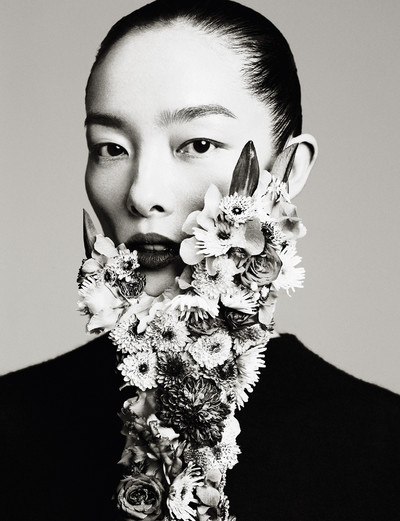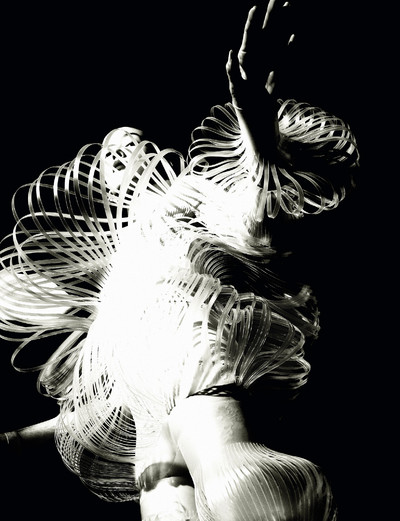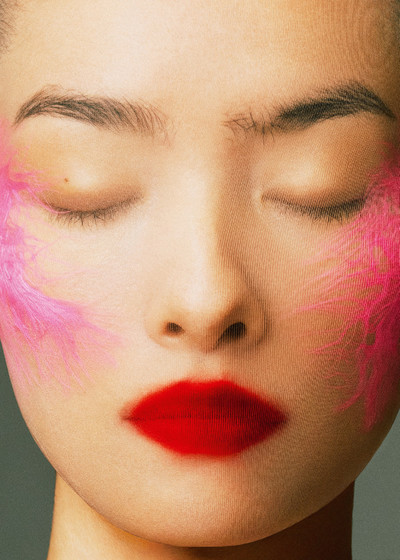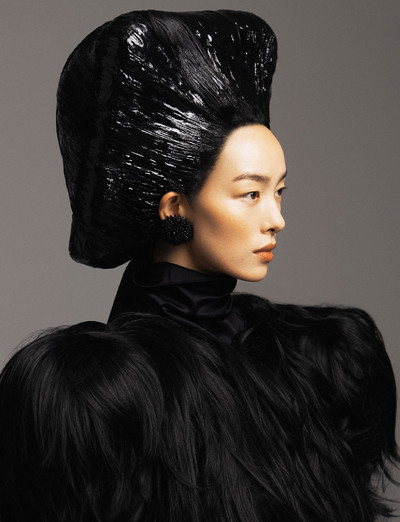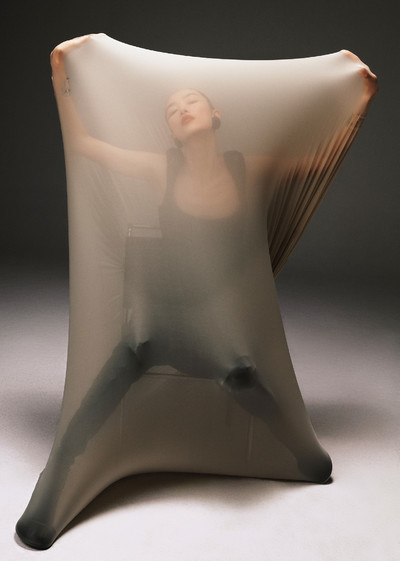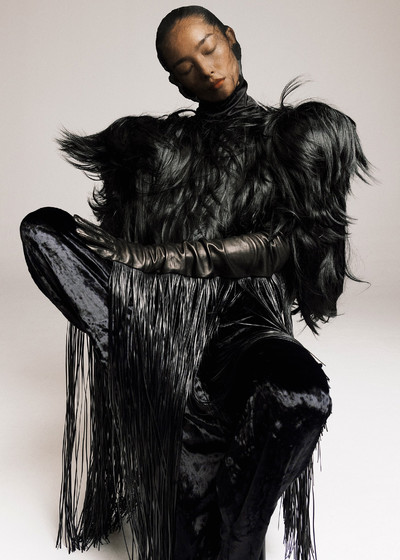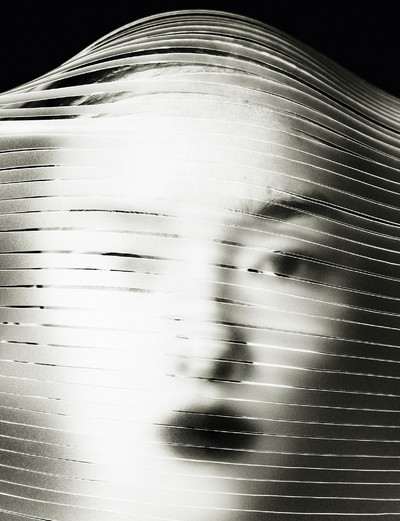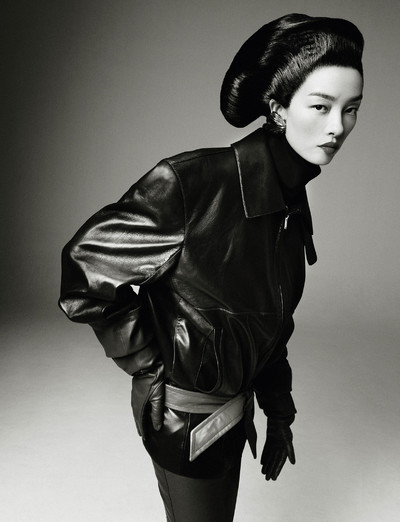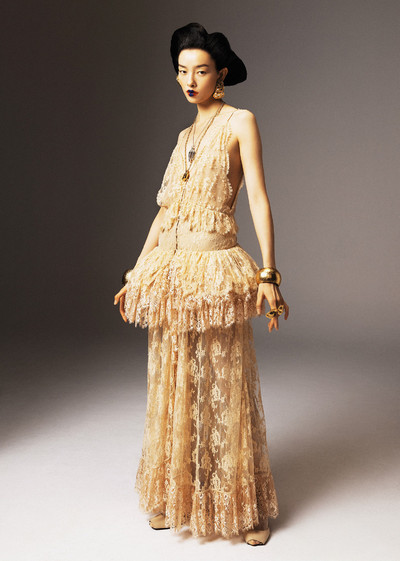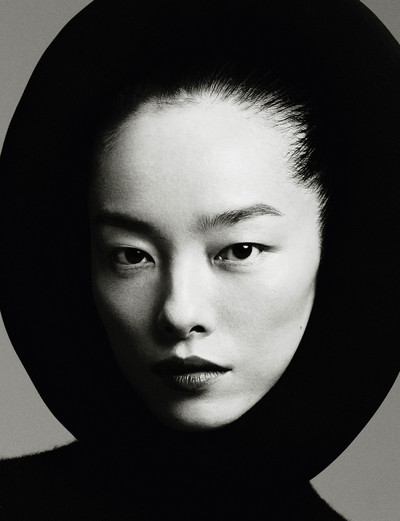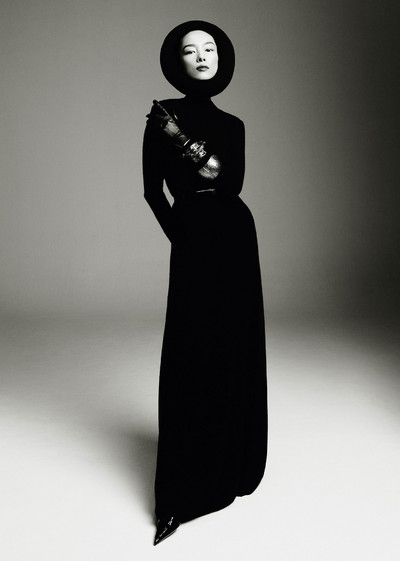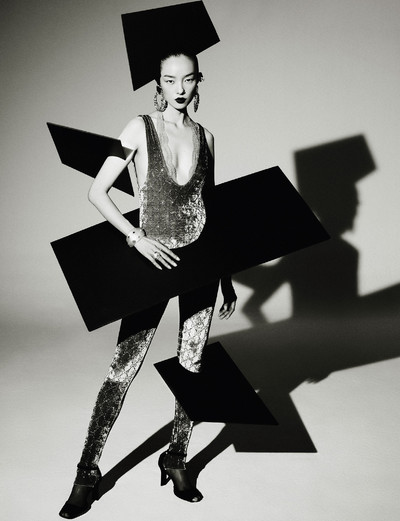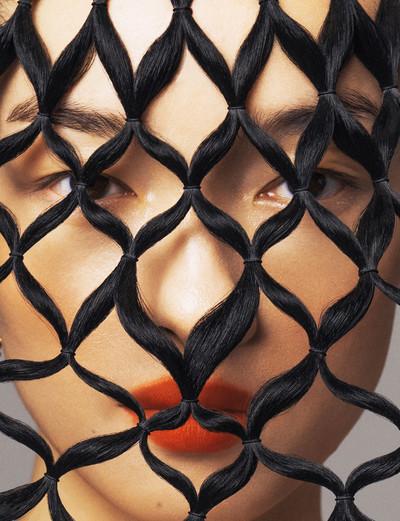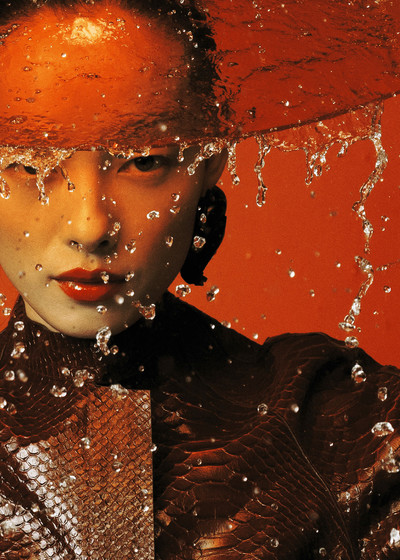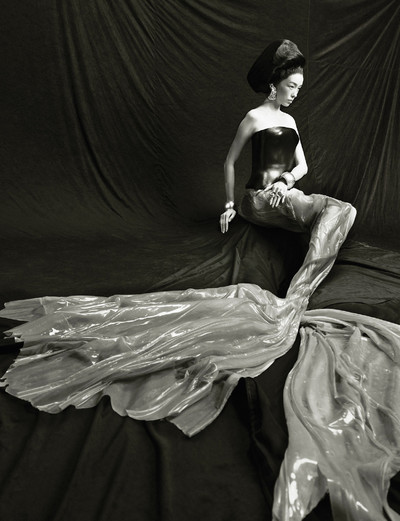Interview by Leslie Sun
Photographs by Zhong Lin
Styling by Austin Feng
‘Emotional honesty is non-negotiable.
I won’t create something that feels empty just because it looks ‘pretty’. The image has to carry a feeling, a truth, even if it’s subtle, surreal or strange. If it doesn’t move something inside me, I can’t fake it for the sake of aesthetics.’
Zhong Lin and I have known each other for eight years. We first met on set in Taipei in 2017, during the early stages of her career. She was the photographer and I was the subject, long before I became an editor and she rose to international acclaim. Zhong Lin was one of the first photographers I worked with after joining Vogue Taiwan in 2020, and we’ve since collaborated closely and witnessed each other’s professional growth. Together, we’ve created some standout covers and stories, including ‘Heat Wave’ from the January 2022 Sustainability Issue, and, more recently, Tilda Swinton from December 2024. It’s also been meaningful to be part of key moments in her career, including the development of her now-famous project 365: a challenge to create and publish a new original photo on her Instagram every day for a year, starting from scratch each day during the Covid pandemic.
Working with Zhong Lin is always a treat – she has that rare ability to transform big ideas into visual poetry, and I’ve always been fascinated by the inner workings of her mind. Although Zhong and I see each other often, we had never truly sat down for an in-depth conversation until now.
Leslie Sun: I think this interview satisfies a lot of my curiosity towards you, even though we’ve known each other for a long time. We met around 2017, and that’s when you first moved to Taipei, right?
Zhong Lin: At that time I was still travelling between Malaysia and Taipei, and starting to pick up my career as a photographer.
So that was the beginning of everything. Wow, I’ve known you since the beginning! That’s cool. I know that you’re a self-taught photographer. What motivated you to teach yourself photography?
I majored in advertising and took some basic photography classes during my university years. I wanted to do fine art photography, but like all typical traditional Chinese families, my dad thought fine art would starve me to death. So he wanted me to choose something that combined art and commerce. At the time, I thought it was a pretty good deal, as I was willing to do anything just to get closer to art. None of my family members or relatives work in or even near the creative field; I think I’m the first. They all come from business backgrounds, so in many ways, my path probably felt foreign or risky to them. I first learned black and white photography using analogue film, and when I developed my own prints in the darkroom I instantly felt drawn to the medium. The desire to become a photographer came naturally, though not necessarily as a career at the time. I just knew I wanted to get into the world of photography. When it comes to being self-taught, I think it was more about realising how you develop your own identity and visual language. That’s something I’m still exploring to this day.
Your style has developed into such a distinct one. Can you tell me about your process of self-discovery? How did you come to establish your own aesthetic and creative voice?
I didn’t really follow a formula. I’m more of an intuitive person and let things come naturally. In fact, I didn’t even realise I had a style until people started pointing it out to me, saying my work inspired them or had a certain feeling. I’ve always been open to change and try not to put myself in a box. I follow what excites me and stay receptive to opportunities that move me. I have asked myself before, ‘ok, who am I? What is my style? What is my aesthetic?’ without realising that I already had one.
And since then, have you started to recognise it?
Not really, to be honest. It’s weird.
I actually think that’s great! Often when artists and creatives start noticing they have a distinct style, they tend to become confined by it. So it’s liberating that it’s still ambiguous for you, that you’re not trying to chase a specific aesthetic or overanalyse it.
True. I used to chase it. At one point, I was eager to find a distinct aesthetic, like when you look at Tim Walker or Guy Bourdin, you instantly know it’s them. I always felt like I didn’t have that. I think it’s because I grew up in such a culturally diverse environment. In Malaysia, I could be watching Bollywood movies on TV while eating my mom’s home-cooked Chinese food, with my dad’s Malay songs playing in the background. It was a beautiful cultural clash. I was exposed to so many styles and conceptual elements, and in love with so many of them, that choosing one distinct style felt difficult. So, I just let inspiration come to me naturally. Eventually, I realised, you know what? You don’t have to force yourself to define anything. It’s all you and part of your evolution.
‘I’d watch Bollywood movies while eating my mom’s Chinese food, with my dad’s Malay songs playing in the background – it was a beautiful cultural clash.’
Were there any photographic influences, whether Asian or Western, that informed you as you began to establish your aesthetic?
There were so many influences it’s impossible to name every one, but a few that stood out were films like Wong Kar Wai’s Fallen Angels, Katsuhiro Otomo’s Akira, Satoshi Kon’s Perfect Blue, and the magical worlds of Hayao Miyazaki. They taught me about mood, emotion, and storytelling through visuals. In photography, I’m drawn to Guy Bourdin’s striking use of colour, Helmut Newton’s provocative boldness, Irving Penn’s still lifes, and Nan Goldin’s intimate documentation of diverse communities.
I want to get into your process next. We’ve been working quite closely together for a couple of years, and the covers you’ve shot for Vogue Taiwan have always been very well received. I truly believe you’ve been a big part of our success. It feels so comfortable working with you. Usually, I’ll throw out a big idea or a message I’d like to convey, then we’ll discuss it with the team. You’ll come back with your thoughts and ideas, which are almost always spot-on with the visual messaging, and of course, the end result always tells a compelling story. What is your personal process from concept to image?
My process is quite fluid. It shifts depending on the project. But usually I like to start by giving the shoot a title, something personal, even if the project already comes with a name. That title helps me create a mood or direction, and from there I’ll often write a short script or a narrative, just to get a feel for the emotional tone. Research is a big part of my process. I collect all kinds of references, but I tend to avoid looking at fashion photography or other photographers’ work. I pull from illustrations, objects, design, architecture, even food imagery. It helps me stay connected to something more intuitive and less expected. I always make a moodboard. I adore moodboards. Sometimes I’ll go back and look at them long after a shoot is done, just to reconnect with the feeling. It’s like flipping through a visual diary. But once I’m on set, I let go. I like to leave space for chaos, for the unexpected. That’s usually where the real magic happens. I love exploring new forms of visual expression and creating what hasn’t been seen before. I think the key to so many of our successful cover collaborations is our mutual trust; there is room to be experimental and try new things.
Which cover story is your favorite?
I think it would have to be the ‘Heat Wave’ issue from January 2022. It wasn’t the most glamorous, but it really meant something. It felt necessary.
That was my favourite too. I think it was so impactful in terms of what a single image can convey. We talked about climate change and pollution with an unknown girl holding a popsicle.
What made it powerful, to me, was the decision to cast someone unfamiliar, Peng Chang. She wasn’t a celebrity, nor a public figure, and that was exactly the point. We wanted the viewer to imagine what happens when we keep creating waste and ignoring the warning signs. Working with someone anonymous gave space for reflection and allowed people to see the bigger picture instead of focusing on a personality. When you told me you wanted to approach the story in a way that created real awareness beyond recycled or eco-friendly materials, it challenged all of us to think deeper. Fashion is a major contributor to waste, so if we’re going to talk about it, we have to do it consciously. No artificial sets were built, all of our backdrop was authentic to the natural environment, and we used recycled materials to create props like the mermaid tail and fin. Everyone on the team worked with purpose. We cut down what we could, stripped things back, and focused on emotion, not excess. That was the heart of it for me, using a visual language to ask viewers: ‘What kind of world are we leaving behind?’
What I found rewarding was that the cover sparked so much conversation with no supermodel or celebrity involved.
It was also Peng’s first cover which made it even more special. There was something raw and honest about it. On a personal note, the popsicle was actually part of an art project I came across a few years back, created by a collective from the National Taiwan University of Arts. They collected polluted water samples from 100 locations in Taiwan, froze them into popsicles, and preserved them in resin. The result was disturbing and beautiful at the same time. I saved the images back then, not knowing I’d one day draw from that memory. But during the development of this shoot, it came back to me, like dots connecting. At the end of the day, I know I’m not saving the world with fashion, but I do believe we can send powerful messages using the tools we have. This cover, for me, was one of those moments. A way to do a little more than just make something look beautiful.
Then, of course, there’s Tilda Swinton, who you shot for Vogue Taiwan! [December 2024 issue]
That’s another cover that I’ll never forget, for obvious reasons. It’s Tilda! The whole shoot was outdoors on a brutally hot, humid summer’s day in Taiwan, and Tilda was wearing Chanel Autumn/Winter, yet she handled it like a graceful ice queen dropped into the tropics. Calm, composed and effortless. But the pre-production process was intense. The producer proposed a few locations, but they’d already been used too many times, shot to death, reposted by influencers, overexposed on TikTok. We didn’t want that. We wanted something untouched, something real.
I remember you were scouting for days! Driving to different locations, sometimes multiple times.
Yes, and in the end, we chose Keelung. It wasn’t an obvious choice. In fact, I don’t think it had ever been used as a location for a high-fashion editorial, but that was the magic. It was very local: fish markets, small streets, gritty corners. I remember playing Ryuichi Sakamoto in the background while we shot. The music gave the whole experience this strange, poetic tension: Tilda in Chanel surrounded by the raw texture of Taiwanese street life, created a beautiful clash. And I could tell she loved it. Both of these covers reminded me of why I do what I do. In fashion, you’re not saving the world, but when you do it right, you can make people pause and feel something.
‘I wanted to do fine art photography, but as with all typical traditional Chinese families, my dad wanted me to combine art with commerce.’
Let’s go back to talking about your career trajectory. There seem to be violent and abrupt ways that people’s careers can take off in the fashion industry, right?
It could be from just one collection or one cover shoot. What would you consider to be your breakthrough moment?
Project 365 was definitely one of the most memorable breakthroughs in my career. The world had come to a halt because of the pandemic and I happened to be stuck in Taipei at the time. I was forced to stop moving and travelling, but I definitely didn’t want to stop creating. I remember that we were still allowed to do shoots in Taipei, thanks to Taiwan’s early detection and prevention measures during the pandemic. So I told my assistant, ‘Let’s finally do this project I’ve always wanted to try.’ I had attempted it once before and failed, but this time felt different, it felt like the right moment to refocus. This project broke me though. [Laughs]
I remember one time you were shooting a cover for us, and when we wrapped late at night, you were like, ‘Ok, I have to go and do the 365 now.’ I thought you would just shoot something on the spot but then realised you were going to build a new set and work with a separate model to go with the concept you came up with on that day.
For me, 365 was about showing up, practicing discipline and diving into self-discovery. Sometimes we wait for inspiration to come, when inspiration is all around us every day. It wasn’t about perfection, but more about the day-to-day commitment. In the end, there was a lot of honesty in those photos, which meant a lot of imperfections and unplanned surprises too. Things that I learned to embrace.
And there was no cheating! You couldn’t say, ‘I’m too busy tomorrow so I’m going to shoot two images today.’
No, there was absolutely no cheating. Part of the rule was that I needed to post an image on my Instagram account every single day, and that was a big challenge in itself because I’m not much of a social media user, but I stayed consistent with it all year because of 365.
‘I start by giving the shoot a title, which helps me create a mood. From there I’ll write a short script or a narrative, to get a feel for the emotional tone.’
I’m curious about how you choose your projects now. What do you look for when considering a project?
Again, I’m very intuitive. It’s about my gut feeling. If someone draws me in, I’m immediately curious and want to reveal a different side of them, especially if they’re already known in a certain way to the public. I’m intrigued by the contrast between their public image and their more intimate, unseen self. Sometimes I’m drawn in by a concept, sometimes by the person themself, especially if it’s someone I admire. But ultimately it’s about connection. I choose projects that feel like they’re connecting the dots back to my own life. It has to click.
Your subject matter nowadays ranges from local models to Hollywood superstars. What are the differences in approach, if any? Are there compromises you have to make when working with high-profile talents?
I approach everyone the same. Whether it’s a first-time model or a Hollywood name, I treat them as human. My goal is always to connect, to find that one honest moment between us that tells a story. That doesn’t change. Of course, with high profile talents, there are often more layers to navigate: image control, larger teams, tighter schedules and sometimes an invisible weight of expectations. Time becomes precious and there’s a lot of negotiation around what can or can’t be shown. But even with all that, I still try to create space for spontaneity. I don’t believe in over-directing or forcing something to happen. The challenge is just finding that truth a little faster, a little more gently, within the framework they’re willing to step into. It’s like a dance between strangers, and finding that connection along the way. Again, I love to photograph the unseen side of people. I think it’s really interesting. And I especially love when someone well-known is open minded. There’s this confidence and trust from them that also allows you to be fearless about pushing their limits. I really enjoy that.
We all know that the unexpected often outweighs the expected on set. How do you navigate unexpected chaos on set?
I embrace it. Chaos is part of the creative process, it’s not the enemy. It’s often where the magic hides. I come prepared, of course, but I never hold on to my plans too tightly. I trust my instinct and let the moment lead. I tell myself, ‘That could be the shot you need.’ Things always happen for a reason. Sometimes, the most powerful images are born from what wasn’t supposed to happen.
Yes, I can see a lot of that spontaneity in your photographs.
Sometimes when things go too smoothly the pictures turn out very expected.
What about the different entities that commission you now. Do you feel different dynamics at play between an editorial commission and a commercial shoot for a major brand?
I remember crying for hours after my first commercial shoot because I had no creative control. What the client ended up wanting was so different from what we had originally discussed. When I tried to talk to them about it, the producer said, ‘It’s commercial, don’t risk making the client unhappy. Just take your money and go.’ For a long time I saw commercial work as just a money job. But things changed as my career grew and my aesthetic became stronger. Now, brands come to me because they want my visual language, my style. I’ve learned that commercial work doesn’t have to lack passion. The dynamic is still different from editorial. Editorial feels like my own world, built with a team I choose, where freedom is limitless. Commercial work, on the other hand, is their world; their boat. But I’m the sailor steering it toward their destination. There are lines I have to respect, but there’s still room to play within them. And sometimes, if I’m lucky, I can convince them to push beyond those lines with a better idea. That’s when commercial work becomes exciting, not restrictive.
Are there any boundaries or parameters in your creative process that you will not compromise on whatsoever?
Emotional honesty is non-negotiable. I won’t create something that feels empty just because it looks ‘pretty’. The image has to carry a feeling, a truth, even if it’s subtle, surreal or strange. If it doesn’t move something inside me, I can’t fake it for the sake of aesthetics. Another thing I won’t compromise on is the people I work with. I won’t collaborate with anyone I don’t feel comfortable around. I believe energy shows up in the final image, and I choose to surround myself with sincere, grounded people – people who truly love what they do and treat everyone on set with respect. That kind of environment allows creativity to breathe. No ego, no politics, just real connection, mutual trust and shared passion. That’s the kind of space where the work becomes magic.
‘I cried for hours after my first commercial shoot because what the client ended up wanting was so different from what we had originally discussed.’
What are the biggest challenges you’ve faced so far in your career?
I think one of the biggest challenges is figuring out how to keep moving forward, especially in an industry that constantly resets the bar. You achieve something and for a moment it feels like you’ve made it, but that feeling fades fast. You can’t stay in it too long, or you risk getting stuck. For me, growth has to stay active – emotionally, mentally, creatively, but also by consciously making time to achieve it. Another challenge, personally, is socialising. I don’t really do parties or big industry events. I find it hard, even exhausting, to communicate in environments full of strangers. Let’s be honest, you’re not really going to have deep conversations in a room like that. I’m not wired for surface level talk. So I choose to stay grounded, keep my circle tight and focus on doing the work, because that’s the part that brings me clarity, purpose and peace.
I can totally relate to that. I also find big social situations tough. Are there any challenges that excite you?
The challenges that excite me the most now are the ones that ask me to go beyond photography: to push myself out of my comfort zone and build something bigger, more long-term and more meaningful. That’s the mountain I want to climb. For example, exploring different creative mediums such as film or collaborating with people from outside of the creative disciplines. Challenging the known and exploring new ways of seeing, thinking and working.
How do you see the role of a fashion photographer today? And how do you think it has shifted since you first started?
A lot has changed, more than I expected. When I first stepped into this world, I envisioned time to think, space to explore and the luxury to build a story from the ground up. But now everything moves so fast. We’re living in a scroll-driven culture, and that pace has reshaped the way we work. There’s much less time for deep brainstorming, proper preparation and meaningful collaborations. Shoots that used to take days now get squeezed into hours, and while technology makes things more efficient, I do think we’re losing something in the process: the emotional layers, the quiet tension, the slow burn of building a narrative. Today, being a fashion photographer is no longer just about making beautiful images. It’s about adaptability, speed and, often, strategy. In the world we live in now, anyone can be anything. You can basically call yourself a photographer if you own a camera, or a smartphone. I used to feel frustrated by this, but now I’ve started to embrace it. In a way, it’s actually cool and kind of amazing. We’re living in a time where you can build anything, as long as you have the drive and the passion. It used to feel like a challenge to stand out, but now I think the real challenge is curation. You can have thousands and thousands of photographers, but what we need, and what I think we’re lacking, are great curators. People with taste. People who know how to select and elevate the right voices, the right work, and show it to the world. That role is more important now than ever.
I couldn’t agree more. What do you want your role to be in this industry?
To be honest, I don’t have a fixed answer for that. I’ve never really sat down and said, ‘This is what I want to represent in the industry.’ But I do know that what I care about most is finding the right audience – or maybe ‘audience’ isn’t the perfect word. It’s more about finding people who feel the same things, or who understand the kind of emotional world I create through my work. That connection is important to me, not for validation but because it reminds me that I’m not alone in the way I see or feel the world. I’m not here to please everyone or to avoid criticism. I’m here to reach my kind of people. That’s why I don’t love overdefining or overexplaining my work. I believe the right people will just get it, visually or emotionally. And when they do, it gives the work more meaning.
‘Technology makes things efficient, but we’re losing something in the process: the emotional layers, the quiet tension, the slow burn of building a narrative.’
Do you consider yourself a photographer or a fashion photographer?
I honestly don’t mind being called either. I think it’s up to people to define it however they see me. I don’t like putting myself in a box.
Do you think there’s a difference between the two?
Yes, I do. To me, being a fashion photographer isn’t just about shooting clothes, you need to have a certain love and passion for fashion itself. It’s about understanding the narrative behind a collection, the vision of the designer and how to translate that into an image. It also requires the right attitude, not just creatively, but professionally. You need to know how to build a strong team around you – stylists, make-up artists, hair, set – everyone plays a role in shaping the story. I think fashion photography is deeply collaborative. You can’t do it alone. It’s a shared rhythm.
Finally, why did you choose Fei Fei [Sun] as your subject to represent you in this issue of System?
The reason I chose Fei Fei is because she’s someone I’ve always quietly admired. I shot her once for Vogue China, and that experience really stayed with me. What I love about her is that she’s incredibly selective. You don’t see her on every cover or in every campaign. There’s something powerful about that. She chooses carefully, and that makes every appearance meaningful. When I spoke to her, she was so humble and real, not pretentious at all. I’m really drawn to people like that. I love working with people who are sincere and grounded, especially in an industry that can feel performative sometimes. And here’s a secret! Fei Fei was the first Asian model I ever loved, way before I even knew I’d be part of the fashion world. I used to quietly hope that one day I’d get to photograph her. She has no idea about any of this, of course. But now that I’ve had the chance, I really want to create something more personal with her again for System. Something intimate, something that speaks more to who we are beyond the surface.
Model: Fei Fei Sun at Elite Management
Hair: Minghu Zhang (HairPro)
Make-up: Yooyo Keong Ming
Set designer: Sisi Zou
Producer: Zhang Qiran
Photography assistant: Yuanling Wang
Styling assistants: Sean Liu, Kaiyin Li, Jiaying Xi
Set designer assistant: Nini
